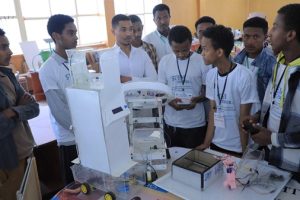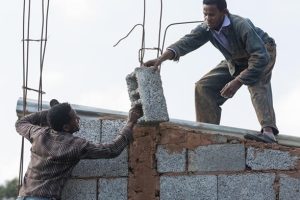
In a society where girls and young women are conventionally mistreated and endure a lifelong agony, a goal of realizing inclusive and equitable development would not be achieved.
Currently, about 200,000 female children are born every day. But we haven’t yet transcended the practices of child marriage and Female Gentile Mutilation (FGM), which put the lives of most these young girls in jeopardy. Have there been signs of progress? Yes indeed, but not enough.
The effort to curb abuse and violation of girls still continue as an uphill struggle which needs the active and urgent participation of all humanity. Though everything beautiful has its fingerprints on them, women are still, in some societies, seen as sex objects and creatures that have no significant contribution to the all-round progress of humanity.
The UN Resolution on Child, Early and Forced Marriage from 2014 recognizes “that child, early and forced marriage is a harmful practice that violates, abuses, or impairs human rights and is linked to and perpetuates other harmful practices and human rights violations, that these violations have a disproportionately negative impact on women and girls, and underscoring States’ human rights obligations and commitments to promote and protect the human rights and fundamental freedoms of women and girls and to prevent and eliminate the practice of child, early and forced marriage.”
Apart from ending up complicating the lives of women and leave them to impairments ranging from psychological to physical, emotional to social, such harmful practices have massively wilted a country’s economy.
Ethiopia’s economy could potentially lose billions of dollars annually due to child marriage, says a report by the World Bank and the International Center for Research for Women, which was launched about a year ago together with the Ministry of Women and Children’s Affairs. In contrast, ending the practice of child marriage would have a large positive effect on the educational attainment of girls; control population growth, and increase women’s expected earnings and household welfare.
The report, titled Economic Impacts of Child Marriage: Ethiopia Synthesis Report, is part of a global program of work funded by the Bill and Melinda Gates Foundation, the Children’s Investment Fund Foundation, and the Global Partnership for Education. According to the study, the prevalence of child marriage (marriage or union before the age of 18) remains high in Ethiopia, affecting more than one in three girls. In addition, almost one in five girls gives birth before the age of 18.
“Child brides are often robbed of their rights to safety and security, to health and education, and to make their own life choices and decisions,” said Quentin Wodon, Lead Economist at the World Bank and author of the report. “Child marriage not only puts a stop to girls’ hopes and dreams. It also hampers efforts to end poverty and achieve economic growth and equity. Ending this practice is not only the morally right thing to do but also the economically smart thing to do.”
In Ethiopia, about four out of five early childbirths (children born to a mother younger than 18) are attributed to child marriage. The report estimates that a girl marrying at 13 will have on average 24 percent more children over her lifetime than if she had married at age 18 or later. Ending child marriage could reduce total fertility rates by 13 percent nationally, leading to reductions in population growth over time.
The analysis suggests that by 2030, gains in annual welfare thanks to higher GDP per capita from lower population growth could reach close to five billion USD in Ethiopia.
The Government of Ethiopia has launched a five-year national roadmap to end child marriage and female genital mutilation (FGM). The plan, coasted at 94 million USD, outlines key strategies and interventions the Government and its partners intend to implement in order to achieve the ambitious national goal of eliminating these harmful practices by 2025.
According to UNICEF Ethiopia, the roadmap outlines five strategies: Empowering adolescent girls and their families; Community engagement (including with faith and traditional leaders); Enhancing systems, accountability and services across sectors; Creating and strengthening an enabling environment; and increasing data and evidence generation and use.
Funding for the roadmap will come from the government’s sectoral budgets, commitments from development partners, the private sector, and community-based initiatives.
“The will to end child marriage and female genital mutilation exists,” said President Sahle-Work Zewde. “I am delighted that we now have a plan which is a clear demonstration of the Government’s commitment to make harmful practices history in Ethiopia.”
UNICEF Representative Adele Khodr, also speaking on behalf of UNFPA and UN Women, lauded Ethiopia’s commitment to ending harmful practices and said no sustainable development could be achieved unless the situation of girls was improved. She called for accelerated progress.
“For Ethiopia to meet the Sustainable Development Goals of ending child marriage and FGM by 2030, the pace of progress it has made in the last ten years needs to be six times faster on child marriage and seven times faster on FGM,” she said.
The launch of the roadmap comes against a backdrop of steady progress in ending child marriage and FGM. The percentage of women aged 20-24 years who were married or in a union before the age of 18 declined from 60 percent in 2005 to 40 percent in 2016. Similarly, the prevalence of FGM among girls and women aged 15 to 49 years declined from 74 percent in 2005 to 65 percent in 2016 .
These rates of progress, however, mask regional variations. In the Afar Region, rates of child marriage and FGM have remained stagnant at about 67 percent and 91 percent respectively. Similar stagnation is observed in the Somali Region of Ethiopia where child marriage has remained at about 50 percent for years and the prevalence of FGM is nearly universal at 99 percent.
In launching the roadmap for the period 2020-2024, the Government aims to accelerate progress towards its 2025 target set at the Girl Summit in London in 2014 as well as the Sustainable Development Goals. The roadmap includes costing at federal and regional levels that it is evidence-based and includes a monitoring and evaluation framework for tracking results.
The roadmap was developed through a participatory process led by the Ministry of Women, Children, and Youth and involving the National Alliance to end child marriage and FGM and comprising government, UN agencies, non-governmental organizations, and civil society.
The Ethiopian Herald August 22, 2019
BY LAKACHEW ATINAFU





